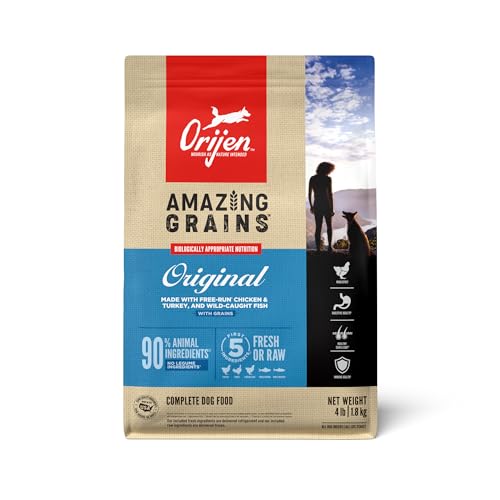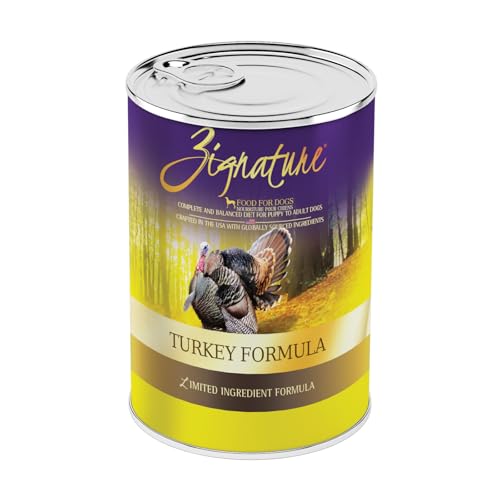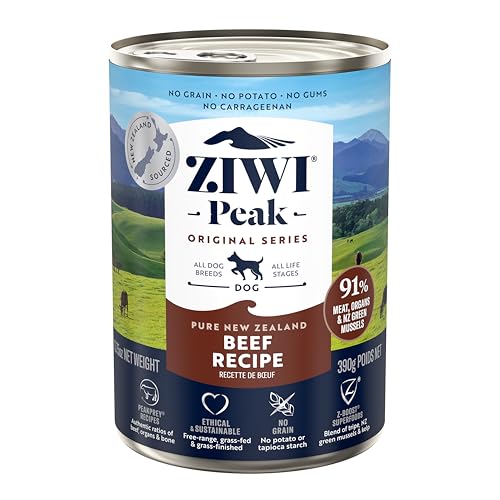Choosing the right dog food can feel overwhelming. The front of the bag is full of appealing pictures and fancy words, but the real story is in the fine print. Learning how to read a dog food label is the most powerful skill you can have to ensure your dog gets the nutrition they deserve. This guide will break it all down for you, step-by-step, turning confusing information into clear choices.
Why the Back of the Bag Matters More Than the Front
When you walk down the pet food aisle, you’re hit with a wave of beautiful packaging. You’ll see pictures of happy dogs, fresh meats, and vibrant vegetables. But here’s a secret: the front of the bag is a billboard, not a report card. The back and side panels, however, are the legal document. This is where legally required information is located, and it reveals the food’s actual nutritional value.
Who Makes the Rules? Understanding the FDA and AAFCO
Before we dive into the label itself, it’s helpful to know who sets the rules.
- The U.S. Food and Drug Administration (FDA): The FDA is the government body with legal power. Their job is to make sure all animal foods are safe to eat, produced under clean conditions, and labeled truthfully.
- The Association of American Feed Control Officials (AAFCO): AAFCO is a private, voluntary group, not a government agency. It has no direct regulatory authority. Its primary role is to create standardized ingredient definitions and nutritional requirements. These AAFCO dog food regulations are published as “model” regulations that states can adopt into law, effectively becoming the national benchmark.
Decoding the Product Name: What’s in a Name?
Thanks to AAFCO’s model regulations, the wording of the product name is a legally binding code that tells you how much of the main ingredient is in the food.
The 95%, 25%, 3%, and “Flavor” Rules
| Rule | Wording Example | Minimum Ingredient Requirement (excluding water) |
| 95% Rule | “Beef for Dogs” | 95% Beef |
| 25% Rule | “Beef Dinner” or “Beef Recipe“ | 25% Beef |
| 3% Rule | “Dog Food with Beef” | 3% Beef |
| “Flavor” Rule | “Beef Flavor Dog Food” | No minimum %, only enough to be detectable |
This shows how a single word change from “Beef” to “Beef Dinner” signals a massive drop in required meat content from 95% down to just 25%.
The Numbers Game: The Guaranteed Analysis Dog Food Panel
The Guaranteed Analysis (GA) is the nutrition facts panel for pet food, listing the minimum or maximum percentages of crude protein, crude fat, crude fiber, and moisture. To properly interpret a guaranteed analysis dog food panel, you need one critical skill.
A Critical Skill: Calculating Dry Matter Basis
The percentages listed in the GA are “as-fed,” including moisture. To accurately compare a dry food (10% moisture) and a wet food (78% moisture), you must convert them to a “dry matter” (DM) basis.
- Example: A canned food with 8% protein and 78% moisture is actually 36.4% protein on a dry matter basis, making it much higher in protein than a dry food with 26% protein and 10% moisture (which is 28.9% on a DM basis).
Why the Analysis Only Tells Half the Story (Quantity vs. Quality)
The GA tells you “how much” (quantity), but not “from what” (quality). It doesn’t tell you anything about the digestibility or the source of those nutrients.
The Heart of the Matter: Analyzing the Ingredient List
The ingredient list answers “from what”. Ingredients are listed in descending order by weight before cooking, so the first five ingredients make up the majority of the food.
Expert Secrets: “Water Weight Illusion” and “Ingredient Splitting”
- Water Weight: Fresh meat like “deboned chicken” is ~75% water, making it heavy. A dry “chicken meal” listed second may actually contribute more protein to the final product.
- Ingredient Splitting: A manufacturer might list “pea protein,” “pea fiber,” and “split peas” separately to artificially lower their position on the list.
Evaluating Protein
- Green Lights (High-Quality): Look for specific, named sources like “deboned chicken” and “lamb meal”.
- Yellow Lights (Variable Quality): “Chicken by-products” (organ meats) can be nutritious, but the term lacks specificity.
- Red Flags (Low-Quality): Avoid vague terms like “meat meal” or “meat and bone meal,” as they can come from unspecified and low-quality sources.
A Guide to Dog Food Ingredients to Avoid
Quickly scanning for specific dog food ingredients to avoid can be a clear indicator of a food’s quality.
- Artificial Preservatives: Butylated hydroxyanisole (BHA), butylated hydroxytoluene (BHT), and ethoxyquin are controversial synthetic preservatives.
- Artificial Colors and Flavors: Red 40, Yellow 5, etc., have no nutritional value and are only for human appeal.
- Sweeteners: Corn syrup adds empty calories. Xylitol is extremely toxic to dogs.
- Vague/Generic Ingredients: “Meat and bone meal,” “animal digest,” and “animal fat” are hallmarks of low-quality formulations. This is a key part of knowing how to read a dog food label effectively.
The Most Important Part: The Nutritional Adequacy Statement
This is the ultimate guarantee of a food’s suitability. Often found in small print, it’s arguably the most important information on the label.
What is a complete and balanced dog food?
A food with this statement is intended to be a pet’s sole diet. “Complete” means it has all required nutrients; “Balanced” means they are in the correct ratios.
Formulated vs. Feeding Trials: The Gold Standard
A product’s “complete and balanced” claim is validated in one of two ways:
1. Formulation Method: The label states it was “formulated to meet the nutritional levels established by the AAFCO Dog Food Nutrient Profiles…”. This means it meets the standards on paper.
2. Feeding Trial Method: The label states, “Animal feeding tests using AAFCO procedures substantiate that (Product Name) provides complete and balanced nutrition…”. This is the “gold standard,” requiring a rigorous, multi-week trial with real dogs to prove the food performs well.
A Quick Guide to Marketing Buzzwords
Many terms are regulated, while others are pure marketing.
- Regulated Terms: “Organic,” “Natural,” and “Human-Grade” have very strict AAFCO and/or USDA definitions. Be skeptical of claims like “made with human-grade ingredients,” which is not the same as the entire product being human-grade.
- Unregulated Terms (Marketing): “Premium,” “Super-Premium,” “Gourmet,” and “Holistic” have no legal or nutritional definition and provide no guarantee of quality.
Navigating Modern Controversies: The Grain-Free Diet and DCM
The FDA is investigating a correlation between diet-associated Dilated Cardiomyopathy (DCM) and diets labeled “grain-free” that contain high proportions of peas, lentils, and/or potatoes. The current veterinary consensus advises caution with diets that list these as primary ingredients. For most healthy dogs, a diet that includes quality grains from a reputable company that follows AAFCO dog food regulations is considered a safe choice.
Practical Application: Analyzing High-Quality Labels
This is where the skill of knowing how to read a dog food label truly comes to life. Let’s analyze a few real-world examples.
Just so you know: As a dedicated dog owner myself, I only recommend products I truly believe in. If you purchase through a link on this page, I may earn a small commission that helps me create more in-depth guides like this—at no extra cost to you. I really appreciate your support!
(Learn More)
The Protein-Rich Formula (Orijen Original)
Orijen is a brand that perfectly illustrates the “Green Lights” we discussed. Looking at the label for their Original formula, you’ll immediately notice the first five ingredients are named, fresh or raw animal sources like chicken, turkey, and whole fish. This aligns with the principle of prioritizing high-quality animal protein. Further down the list, you’ll find natural preservatives like mixed tocopherols and beneficial supplements like chelated minerals, checking all the boxes for a premium, nutrient-dense food.
The Limited Ingredient Diet (Zignature Turkey Formula)
In the “Marketing Buzzwords” section, we mentioned “Limited Ingredient Diet” or “LID”. Zignature is a brand that specializes in this. Their Turkey Formula is a great real-world example. The ingredient list is intentionally simple: Turkey is the first ingredient, followed by turkey meal to ensure protein density. The primary carbohydrate source is chickpeas. This straightforward formula with a single animal protein source is what defines an LID, making it a popular choice for owners trying to identify potential food sensitivities.
The “95% Rule” in Action (Ziwi Peak Beef Recipe)
Ziwi Peak’s canned food demonstrates several key concepts. The product name, “Beef Recipe,” is simple, which means it falls under the “95% Rule,” indicating that at least 95% of the product (excluding water) is beef. Furthermore, the Guaranteed Analysis shows a high moisture content (around 78%) and a protein level that might seem low (around 9%). This is the perfect opportunity to use your “Dry Matter Basis” calculation skill. When you do the math, you’ll find the protein content is actually over 40%, revealing it to be a very high-protein food.
Frequently Asked Questions (FAQs)
1. What is the single most important thing to look for on a dog food label?
The Nutritional Adequacy Statement. It’s the manufacturer’s guarantee that the food is “complete and balanced” for a specific life stage.
2. Is “chicken meal” a bad ingredient in dog food?
No, a named meat meal like “chicken meal” is a high-quality, concentrated protein source. Avoid vague, generic terms like “meat meal”.
3. Are grain-free diets bad for dogs?
The issue is complex. The FDA has investigated a strong correlation between a heart condition (DCM) and grain-free diets high in peas, lentils, or potatoes. The veterinary consensus is to be cautious with these diets.
4. How can I accurately compare a wet food to a dry food?
You must convert the guaranteed analysis dog food percentages to a “dry matter” (DM) basis. This calculation mathematically removes the water content, allowing for a true comparison.
5. What does “human-grade” actually mean on a dog food label?
It has a very strict AAFCO definition. Every ingredient must be human-edible, and the entire product must be made in a facility licensed for producing human food.
Conclusion: Your Expert Checklist for Choosing Dog Food
Reading a dog food label empowers you to make decisions based on nutritional science. Use this checklist to evaluate any food:
- Start with the Back: Locate the Nutritional Adequacy Statement. Is it “complete and balanced” for your dog’s life stage?.
- Analyze the Protein: Examine the first five ingredients. Look for named animal protein sources.
- Scrutinize the Guaranteed Analysis: Use the moisture percentage to convert protein and fat to a Dry Matter Basis to accurately compare products.
- Scan for Red Flags: Look for the key dog food ingredients to avoid, like artificial preservatives, colors, sweeteners, and generic “meat” or “animal” terms.
- Consult Your Veterinarian: The final step is to discuss your choice with a vet to ensure it’s right for your dog’s individual needs.
Send Us a Message
For all other inquiries, please use the form below. We look forward to hearing from you!








